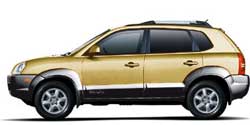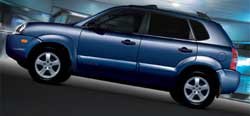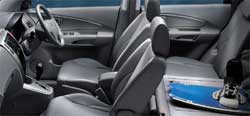

TechnoFILE is copyright and a registered trademark © ® of
Pandemonium Productions.
All rights reserved.
E-mail us Here!

Hyundai Expands SUV Line with TucsonBy Jim Bray Hyundai has upped its SUV ante with the new compact ute Tucson. Why, when it already sells plenty of its Santa Fe? Profitability probability, undoubtedly. The Tucson is smaller than the Santa Fe, as well as being a little more “entry level,” so it allows the Korean automaker an opportunity to introduce a handsome new vehicle and give itself the potential to move the Santa Fe upmarket. The four door Tucson continues Hyundai’s penchant for naming SUV’s after cities in the warm Southern US States, which certainly seemed like a slap in the face when I took possession of a Tucson during a particularly cold and snowy afternoon. Ah, but that turned out to be the perfect occasion to try out this new beast, and it acquitted itself admirably. For you see, like its big brother “from” New Mexico, this Arizona-monikered motor vehicle is just as at home in the north as it is in warmer climes. That explains such amenities in my test unit as seat heaters up front and an HVAC system that warmed the vehicle up and defrosted its windows about as quickly as one could expect during minus temperatures. And of course the Tucson has a lot more crammed onto its list of features than just heat ‘em up things. 
The Tucson is a handsome vehicle, not as curvy as the Santa Fe yet athletic looking without being in your face. It’s a conventional four door ute with top hinged tailgate and among its thoughtful features are rear seats that fold flat in a rather nifty manner and a cargo area floor cover that’s carpeted on one side and rubberized on the other. The Tucson is meant to compete with the likes of the Honda CR-V, Toyota RAV4 and Nissan X-Trail. Of those competitors, I’ve only driven the CR-V, but the Tucson seems well-equipped to take it on head to head. While you may lose some of Honda’s legendary refinement, you can add to the equation such available Tucson features as real four wheel drive and V6 power that can help tilt the scale in Hyundai’s direction. The base Tucson comes with a 2.0 litre DOHC 4-cylinder engine with Continuously Variable Valve Timing (CVVT) and you can mate it to either a five speed manual or four speed automatic. My tester was the top end GLS AWD, which comes with Hyundai’s 2.7-litre V6 engine and a 4-speed automatic transmission with “pretend manual” Shiftronic mode. I thought the Shiftronic mode felt rather muddy and stiff, but it sure came in handy when the roads got slick. The V6 engine is fitted with a variable length, tuned intake system that Hyundai says gives smoother delivery of power across the entire rev band. In use, I found the engine nice and torquey and the Tucson moved along quite nicely. The 173 horses are reached at 6000 rpm, but the 178 lb. ft. of torque are maximized at a more reasonable 4000 rpm so, while these may not be the biggest numbers on the market, they prove more than adequate for the task at hand. The all wheel/four wheel drive system worked well, too, and the all wheel drive mode proved excellent when we sallied forth along a secondary highway that, in places, was snow covered and a little hairier than we would have liked. You can access the AWD “on the fly” via a dashboard-mounted button and the difference it made in the Tucson’s demeanour on the snowy twisty bits was obvious. Tucson uses a Borg-Warner Electronic InterActive Torque Management all-wheel-drive system that, according to Hyundai, “routes up to 99 percent of the available power to the front wheels. As road conditions or torque demand changes, the system automatically diverts up to 50 percent of the available power to the rear wheels.” The system apparently monitors the position of the throttle, the angle of the front wheels as well as their slippage. And when you manually lock the driveline into AWD the torque is split 50/50 between the front and the rear. Stopping the Tucson’s 16 inch wheels are disc brakes (the front are ventilated) with ABS and traction control with an electronic stability program. Brake feel is good and the ABS doesn’t beat you over the head with its presence unless you really jam down the pedal or the traction is really lousy. The steering wheel tilts, though it doesn’t telescope, and the steering is power assisted rack and pinion. It feels fine, though the suspension’s softness means this vehicle definitely handles like an SUV and not like a sports car. That suspension consists of Independent MacPherson struts with gas shocks up front, independent multi-link with trailing arms in rear and both ends get stabilizer bars. 
Inside, the Tucson is a pleasant enough place to spend some time, though our road trip only lasted about ninety minutes at a sitting and by that time the small of my back was feeling a tad tired. Otherwise the leather covered seats (with aforementioned bun warmers) were comfortable and supportive. They adjust manually, and I must admit I never quite found a perfect driving position, but it wasn’t a big deal. The front passenger seat folds down to add even more storage room or become a desk for those times when the driver just has to turn the vehicle into a mobile office. The Tucson also includes such amenities as power windows, power heated outside mirrors and power door locks with keyless entry. The AM/FM/CD/MP3 stereo system has six speakers, a micro antenna on the roof, and reasonable sound. Ergonomically it’s a huge step up from some of Hyundai’s stereos of only a couple of years back, which featured buttons so small I had to put on my reading glasses to discover what they did. The CD player is of the single disc variety, but that’s okay. Hyundai has even put attention to detail into such things as the outside door handles, which are body coloured and have a feel of quality. I could have done without the two tone body cladding (which isn’t unique to this vehicle or manufacturer, alas). On the other hand, you get dual exhausts, cruise control, front fog lights, and a power sunroof that we only got a chance to try very quickly since it was so damn cold outside. My week with the Tucson left me liking the vehicle quite a bit. This wasn’t surprising, since I also like the Santa Fe (especially its newer iterations such as the one with the 3.5 liter V6 and five speed automatic). Hyundai is barking seriously at the heels of the “big guys” and while there are a few touches they still need to work on, such as tactile feel of buttons and knobs and the like, they’re definitely on the right track in offering vehicles of good quality that offer even better value. The Hyundai Tucson GLS equipped like my fully featured tester sells for about $29000 Canadian/$22000 US. Jim Bray is a member of the Automobile Journalists Association of Canada. His columns are available through the TechnoFile Syndicate. |
Support TechnoFile via Paypal |
TechnoFILE's
E-letter We're pleased to offer our FREE private, subscription-based private E-mail service. It's the "no brainer" way to keep informed. Our Privacy Policy |